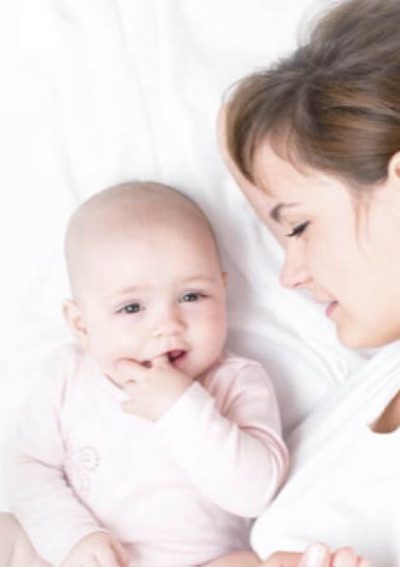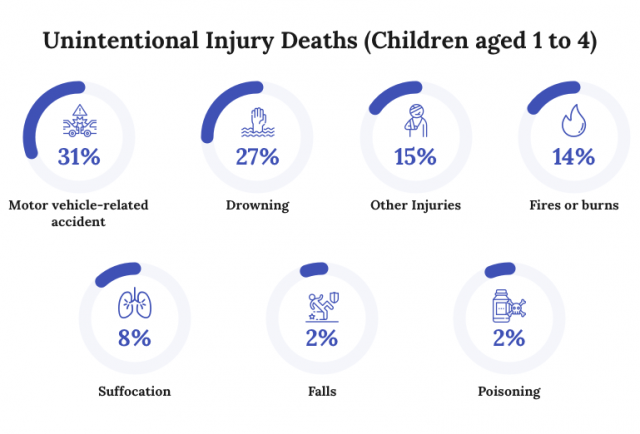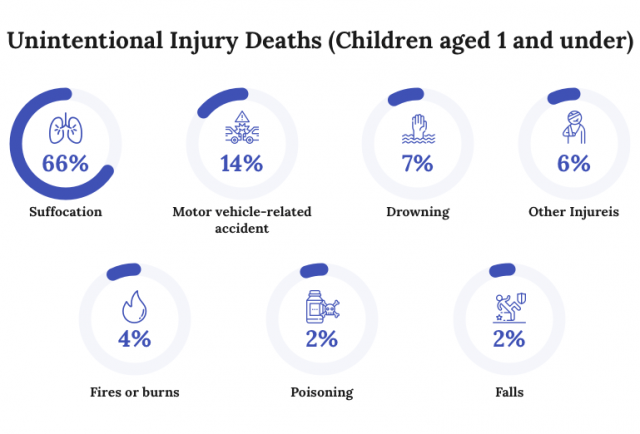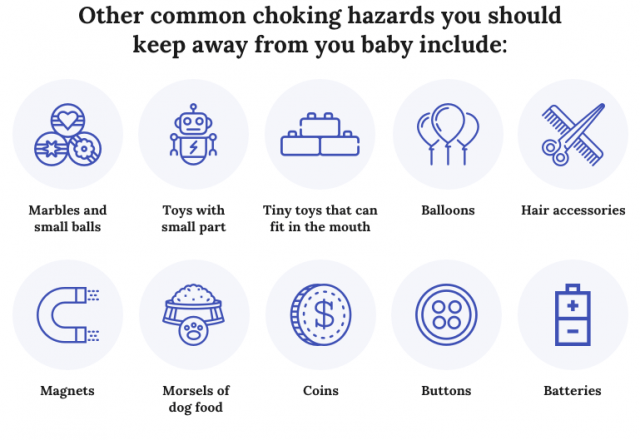Babyproofing Essentials: How to Make Your Home Safe
Unintentional injuries are the leading cause of death of children in the United States, and most injuries happen in and around the home. Fortunately, many accidents are preventable if you properly babyproof your home. Following several simple steps can keep your baby safe from the bassinet to the bathtub and beyond.

Bringing home baby is an exciting moment for any parent, but it can also be one fraught with anxiety. One common area of concern: how to adapt your home so it’s safe for your child.
It’s a critical endeavor. More than 3.4 million children are injured at home each year, and approximately 2,300 children under the age of 15 will die from such injuries.
The good news is that most injuries are predictable and preventable, and by properly babyproofing, you can create a safe and secure environment where your baby can explore and learn.
Babyproofing expert Daniel Leeds of Full House Babyproofing told Consumer Notice that the ideal time to get the house prepared is when your baby is 6 to 9 months old.
“It’s best to have your house prepared before your child is mobile so you aren’t playing catch-up,” says Leeds.
And if you’re not comfortable taking it on yourself, he encourages people to hire a professional like himself. “We know what works and what doesn’t. Also, we know what products are available and will work in your home.”
You can find a childproofing professional in your area on the International Association for Child Safety’s website.

Sleep Safety
Babies spend lots of time in their cribs. Most newborns sleep 16 hours a day, and your baby will continue to sleep for up to 14 hours a day until after their first birthday. Babyproofing the crib and following these sleep safety tips can prevent injuries during slumber.
The crib you choose should adhere to these strict guidelines:
- Crib slats should be no more than 6 cm apart (about the width of a soda can), or your baby’s head could get stuck. Slats should not be cracked, splintered or missing.
- There should be no cutout designs in the headboard or footboard. Your baby’s head or body parts could easily become stuck in the holes.
- Choose a crib without corner posts. Your baby’s clothing could catch on these posts and accidentally strangle them.
- Ensure that all screws, bolts and other hardware remain tight and in place. They can easily loosen if your baby is active, and the crib can collapse.
- Choose a firm mattress that fits tightly inside the crib so your baby can’t get stuck between the mattress and the crib.
- The crib should have no sharp or jagged edges.
- New cribs no longer have side rails for safety reasons. If you are using an older crib, make sure the sides latch securely.
- Use a newer crib if possible. Older cribs may contain lead-based paint, which can poison your baby.
Where you place your baby’s crib also matters. Keep the crib away from windows and blinds, as dangling cords are a strangulation hazard.
Keep in mind that new risks present themselves as your baby grows. Mobile and activity gyms, for instance, can present strangulation risks and should be removed by the time your baby can push him or herself up on their hands and knees, usually around five months of age. Growing babies may also attempt to climb out of their cribs and fall. To prevent accidents, lower the crib mattress as your baby begins to sit and stand up.
Sleep position is critical. Whether it’s for bedtime or a nap, always put your healthy baby to sleep on their back. Babies who are placed to sleep on their bellies are at a much higher risk of dying from Sudden Infant Death Syndrome (SIDS). Pre-term infants have a higher risk of SIDS and should also sleep on their backs.
Keep the crib empty. Pillows, toys, blankets, comforters and bumpers can all create a suffocation risk. Only use a crib sheet if it fits snugly over the mattress. If you are worried about your baby not being warm enough, dress your baby in a sleeper.
There are other ways you can reduce the risk of SIDS:
- Don’t smoke or let others smoke around your baby.
- Don’t use wedges and sleep positioners.
- Keep your baby’s sleep area close to yours (same room) but keep their sleep surface separate.
- Don’t let your baby sleep in a bed or on a couch or armchair with adults or other kids.
- Don’t let your baby get overheated while they sleep.
- Give your baby a clean, dry pacifier when you put them down to sleep.

Furniture Safety
Every 30 minutes, a child is injured when a TV or piece of furniture topples onto them. And approximately every 10 days, a child dies from a tip-over injury.


These injuries often happen when a curious tot attempts to scale a set of shelves or bedroom dresser by pulling out the drawers to create a makeshift stepladder. This shifts the center of gravity of the furniture, causing it to fall over and crush the child against the floor.
Furniture tip-over risks are one of the most overlooked hazards in the home, says Leeds. But tip-overs can easily be prevented by anchoring televisions and large furniture. While newer dressers come with anti-tip devices, you can buy anti-tip kits, brackets and straps to anchor other furniture and appliances, such as ranges and stoves.
The International Association for Child Safety (IAFCS), a network of professional babyproofers, recommends using at least two restraints on every furniture piece. The organization provides easy-to-follow instructions and a video to walk you through the process.
Tip-Over Prevention Tips
- Remove toys, remotes and other tempting objects from the top of dressers, TVs and other large furniture.
- Anchor top-heavy furniture to the wall with brackets, braces or wall straps.
- Place TVs on intended media stands only; not on top of dressers, bookcases, tables or nightstands.
- If possible, mount your flat-screen TV to a wall, or use an anti-tip stand.
- Traditional TV sets (CRTs) should be placed on low, sturdy media stands and anchored to the wall.

Fall Prevention
Falls are the leading cause of death of children and young adults and the leading cause of nonfatal injuries. Approximately 2.8 million children land in the emergency department each year after a fall. Falls are the cause of more than half of nonfatal injuries in children under the age of 1.
Using safety gates at the top of stairs is a must, but choose a gate that screws into the wall. The gates should be easy enough for adults to open and close, but children should not be able to dislodge the gates easily.
Stairs aren’t the only danger. Babies can also roll off a changing table, slip out of a high chair or roll off a bed or couch. Never leave your child unattended on a changing table or in a high chair.
Fall Prevention Tips
- Use preinstalled safety straps on changing tables and high chairs.
- Keep stairs free of clutter, and get rid of loose rugs.
- Don’t leave your baby or toddler unattended on a porch or balcony, even if railings are present.
- Place car seats and bassinets on the floor — not on tables, countertops, beds or other furniture.
- Don’t use baby walkers, as they can lead to falls.
- Don’t rely on window screens to prevent your baby from falling out a window.
- Install bumpers and guards on sharp edges of furniture to protect your baby or toddler from cuts and other injuries.

Window Safety: Falls and Cord Hazards
Approximately 5,200 children fall out of windows each year, according to a 19-year study published in the journal Pediatrics. Children under the age of 4 are more likely to sustain head injuries, be hospitalized and die than older children, the study found.
Window guards and window stops can help prevent such tragedies.
Window stops are small mechanisms or wedges that keep windows shut or prevent a window from opening more than a couple of inches. Window guards, on the other hand, allow you to still open your window for airflow but prevent your child from falling out of it.
Window guards screw into the side of a window frame and have bars (no more than 4 inches apart). Keep in mind that most five-year-olds can fit through a six-inch window opening. They should be very difficult for young children to open, but easy enough for an adult to open to escape from a fire or other emergencies.
Blinds can also pose a deadly risk to babies and children, who can easily become tangled in the cords. More than four dozen children died between 2012 and 2017 after becoming entangled in the cords of blinds, according to the CPSC. Many of those deaths occurred when the child was alone in their room to sleep, play or watch TV.
Go Cordless! The CPSC recommends using only cordless blinds in homes where children live or visit and offers these safety tips:
- Move cribs, beds, furniture and toys away from cords and windows.
- If you use blinds with cords, make tasseled pull cords as short as possible.
- Anchor continuous-looped bead chains and cords to floor or wall.

Electrical Hazards
Once they start to crawl, babies seem magnetically drawn to electrical outlets, and that can be a recipe for disaster. In fact, most electric shocks in young children are caused by them sticking metal objects into unprotected electrical outlets and appliances or biting into electrical cords.
There are numerous devices on the market, ranging from outlet caps and covers to outlet plates. But because toddlers can easily remove an outlet protector, the best option is to install a tamper-resistant outlet.
That said, even tamper-resistant outlets aren’t completely tamper proof, so be sure to keep a close eye on your baby when they begin to crawl and explore.
Other steps that can minimize electrical hazards include:
- Putting furniture in front of outlets to make them harder to get to and hiding power strips so your baby can’t see them
- Having an electrician uninstall outlets you aren’t using
- Talking to your child as they grow and teaching them about electrical dangers

Choking Hazards
One of the key ways babies discover the world is with their mouths, and as every new parent quickly discovers, nothing is off-limits. Various foods, toys and virtually any other small object can pose a choking risk.
According to the Centers for Disease Control and Prevention, some foods should not be given to children under the age of 1. These include pieces of raw fruit or vegetables, hot dogs, chunks of meat, grapes, peanut butter, popcorn, hard candies, marshmallows and gummy candies.

A child can even choke to death on something as innocuous as ground cinnamon. Babies can accidentally inhale the powder into their lungs and asphyxiate.

Batteries and Magnets
Button batteries, in particular, can be lethal to a baby or child. The nickel-sized lithium batteries are commonly found in hearing aids, remote controls, greeting cards that play music and numerous other household items.
They can easily become stuck in your child’s esophagus and burn through it in just two hours.
Babies who’ve swallowed the batteries may require surgery and can end up with life-threatening complications that require feeding and breathing tubes, according to the National Capital Poison Center. They can also cause injury if a child puts them in their nose or ear.
Be sure to secure any household item that uses batteries by placing strong tape over the battery compartment. Better yet, purchase items that require a screwdriver to open battery compartments.
Magnets can also cause serious injury if swallowed. If they’re swallowed, they have enough force to connect to each other through different parts of the intestines, causing the bowel to rip or tear. Don’t give your child any toys that contain magnets until they’re old enough to understand how to properly use them.

Poisoning Prevention
Every day, more than 300 children are treated for accidental poisoning and approximately two die. There are ways to poison-proof your home and protect your child.
To start, get on your hands and knees in every room and explore what chemicals are within your child’s reach. Keep in mind that common household items — such as mouthwash, laundry detergent pods and essential oils — can be hazardous to a child.
Next, place any potentially harmful products or poisons out of sight, out of reach and preferably locked away.
Common Household Poisons
- Laundry detergent pods, powders, liquids
- Dishwasher pods, powders, liquids
- Food extracts, such as vanilla and almond
- Ammonia-based cleaners
- Bleach products
- Baby bottle cleaners
- Floor polish and liquid floor cleaners
- Oven cleaners
- Stain removers and ironing aids
- Medications
- Mouthwash, perfume and aftershave
- Cosmetics and personal-care products
- Soaps, bodywash, shampoos and conditioners
- Deodorants
- Alcohol
- Hair dyes and hairsprays
- Nail and shoe polish
- Nail polish remover
- Nail glue removers
- Drain openers and toilet bowel cleaner
- Alcohol
- Houseplants
- Room deodorizers, potpourri and incense
- Mothballs
- Matches
- CD and DVD cleaners
- Cigarette butts, electronic cigarettes and refills
- Rat and insect poisons
- Automotive products
- Gardening products (weed killers and fertilizers)
- Glues
- Paints
- Turpentine
- Epoxies and resins (coatings, varnishes, etc.)
- Kerosene
- Gasoline
It’s important to keep all medications in a locked cabinet. This includes prescription drugs, as well as over-the-counter drugs, vitamins and supplements. While many medications come with child-resistant caps, it’s important to know that child-resistant does not mean childproof.
Recreational drugs, e-cigarettes and refill cartridges must also be locked away. Nearly 8,300 children were exposed to liquid nicotine between January 2012 and April 2017. Approximately 9 out of 10 of those exposed were under the age of 3. Liquid nicotine solutions are highly concentrated, and even a small amount that is ingested or makes contact with their skin can kill a child.
- Don’t refer to medication as “candy.”
- Always use child safety caps on medications.
- Take an Infant/Child CPR class and practice.
- Keep the phone number for Poison Control — (800) 222-1222 — near every phone in your home and save it on your mobile phone.

Water Risks: Bath and Pool Safety
Drowning is the leading cause of accidental death among children ages 1 to 4. While most child drownings and near drownings occur in swimming pools and baths, young children can drown in less than two inches of water.
That means drowning can occur in places you’d least expect, including sinks, toilets, buckets and ditches filled with rainwater. Even your pet’s water dish can pose a potential hazard. And because toddlers have heads that are heavy compared to the rest of their body, they may not have enough strength to pull themselves out of a bucket or toilet.
- Keep the toilet lid down and install a latch or clip to prevent your baby or child from opening the lid.
- Never leave buckets containing liquid unattended, and store buckets out of reach of children.
- Always use safety covers and latches on spas and hot tubs when not in use.
- Keep bathroom and laundry room doors securely closed when not in use.
Bath Safety
Never leave your baby unattended in the bath or leave an older child to supervise them. Your child should be within an arm’s reach at all times. Gather up all the bathing supplies you will need in advance, and if you have to leave to answer the door or take a phone call, take your child with you.
In the time it takes to cross the room to grab a towel, your child can slip under the water, and in the two minutes it takes to answer a phone call or respond to a text message, your child could lose consciousness. Irreversible brain damage can occur within four to six minutes.
- Never leave a baby alone in a bathtub for even a second.
- Don’t use a baby bath seat as a substitute for supervision.
- Don’t use a bath seat in a non-skid bathtub because the suction cups won’t stick properly.
- Don’t overfill the tub (2–4 inches of water should be adequate).
- Always empty the tub immediately after use.
Hot water can easily scald a baby’s skin. The Consumer Product Safety Commission urges consumers to lower the temperature setting on their water heaters to 120 degrees Fahrenheit to prevent burns. You can also install anti-scald devices on faucets and shower heads.
Bath spout covers can protect your baby’s head. Depending on how much you want to spend, there are even bath spout covers available with built-in thermometers to ensure the water temperature is just right.
Pool Safety
More than 300 children under the age of 5 drown in swimming pools each year, and more than 2,000 are treated for submersion injuries.
If you have a pool, install a four-sided isolation pool fence. Fences should have self-closing and self-latching gates. The CPSC recommends fences be at least four feet tall, but some states, cities and counties require 60-inch barriers.
You might also consider installing a pool alarm.
A typical pool alarm will sound if your child opens the backdoor that leads to the pool. Separate sensors can detect when the pool gate is opened or when anything falls into the pool and will sound. There are even wristband alarms your baby or child can wear.
When pool season ends, be sure to “winterize” your pool. With above-ground or portable pools, this usually entails draining your pool’s water, removing ladders and putting it away. The goal is to prevent rain or snow from collecting in the pool and creating a potential drowning risk.
Your baby or toddler is not “drown-proof” just because they’ve taken swimming lessons. Be sure to outfit your infant or toddler in a properly fitting life vest whenever they’re near water.
You can learn more about preventing child drownings by reading these pool safety guidelines issued by the CPSC.
45 Cited Research Articles
Consumernotice.org adheres to the highest ethical standards for content production and references only credible sources of information, including government reports, interviews with experts, highly regarded nonprofit organizations, peer-reviewed journals, court records and academic organizations. You can learn more about our dedication to relevance, accuracy and transparency by reading our editorial policy.
- Altkorn, R. et al. (2008, July). Fatal and non-fatal food injuries among children (aged 0-14 years). Retrieved from https://www.sciencedirect.com/science/article/pii/S0165587608001298
- American Academy of Pediatrics. (2013, September 18). Childproofing Your Home. Retrieved from https://www.healthychildren.org/English/safety-prevention/at-home/Pages/Childproofing-Your-Home.aspx
- Borse, N.N. et al. (2008, December). CDC Childhood Injury Report: Patterns of Unintentional Injuries among 0-19 Year Olds in the United States, 2000-2006. Retrieved from https://www.cdc.gov/safechild/pdf/cdc-childhoodinjury.pdf
- CBSMiami. (2017, April 18). Kids Crushed By Furniture A Growing Problem But Can Be Prevented. Retrieved from https://miami.cbslocal.com/2017/04/18/kids-crushed-by-furniture-problem-prevented/
- Centers for Disease Control and Prevention. (2019, May). Choking Hazards. Retrieved from https://www.cdc.gov/nutrition/infantandtoddlernutrition/foods-and-drinks/choking-hazards.html
- Children’s Hospital of Philadelphia. (2013, October). Poison Control Home Safety Checklist. Retrieved from https://www.chop.edu/health-resources/poison-control-home-safety-checklist
- Cronan, K.M. (2018, February). Household Safety: Preventing Injury in the Crib. Retrieved from https://kidshealth.org/en/parents/safety-crib.html
- Cronan, K.M. (2018, May). Household Safety: Preventing Injuries from Falling, Climbing, and Grabbing. Retrieved from https://kidshealth.org/en/parents/safety-falls.html
- Eunice Kennedy Shriver National Institute of Child Health and Human Development. (2007, June). Retrieved from https://www.nichd.nih.gov/sites/default/files/publications/pubs/documents/SIDS_QA-508-rev.pdf
- Gateway Region YMCA. (n.d.). DROWNING FACTS. Retrieved from https://www.gwrymca.org/sites/default/files/Drowning%20Facts%20(1).pdf
- Gaw, C., Chounthirath, M.S. & Smith, G.A. (2017, April). Nursery Product-Related Injuries Treated in United States Emergency Departments. Retrieved from https://pediatrics.aappublications.org/content/pediatrics/139/4/e20162503.full.pdf
- Govindarajan, P. et al. (2018, May). E-Cigarettes and Liquid Nicotine Exposures Among Young Children. Retrieved from https://pediatrics.aappublications.org/content/141/5/e20173361
- Gupta, R.C. (2016, November). Childproofing and Preventing Household Accidents. Retrieved from https://kidshealth.org/en/parents/childproof.html?ref=search
- Gupta, R.C. (2016, October). Household Safety: Preventing Poisoning. Retrieved from https://kidshealth.org/en/parents/safety-poisoning.html
- Harris, V.A., Rochette, L.M. & Smith, G.A. (2011, September). Pediatric Injuries Attributable to Falls From Windows in the United States in 1990-2008. Retrieved from https://pediatrics.aappublications.org/content/128/3/455
- Lee, A. & Volanth, C. (2015, January 26). TVs — Tipping the Scale to Safety. Retrieved from https://www.cpsc.gov//PageFiles/132250/TV-hazard-report-January2015.pdf
- Litovitz, T., Whitaker, N. & Clark, L. (2010, June). Preventing Battery Ingestions: An Analysis of 8649 Cases. Retrieved from https://pediatrics.aappublications.org/content/125/6/1178
- National Capital Poison Center. (n.d.). Batteries Cause Devastating Injuries. Retrieved from https://www.poison.org/articles/button-batteries
- National Fire Protection Association. (2017, May 1). FACT SHEET RESEARCH: Injuries Associated with Electrical Receptacles. Retrieved from https://www.nfpa.org/-/media/Files/Code-or-topic-fact-sheets/InjuriesElectricalOutletsFactSheet.pdf
- Office on Women’s Health. (2018, October 11). Making Your Home Safe for Baby. Retrieved from https://www.womenshealth.gov/pregnancy/getting-ready-baby/making-your-home-safe-baby
- Peters, T. (2017, April 12). Babyproofing isn’t as intimidating as it sounds — here’s how to do it. Retrieved from https://www.today.com/parents/how-babyproof-your-home-it-s-not-hard-it-sounds-t109555
- Poison Control National Capital Poison Control Center. (n.d.). Batteries Cause Devastating Injuries. Retrieved from https://www.poison.org/
- Rapaport, L. (2018, February 19). More U.S. babies dying of suffocation, often in bed. Retrieved from https://www.reuters.com/article/us-health-infants-suffocation/more-u-s-babies-dying-of-suffocation-often-in-bed-idUSKCN1G31YK
- Safe Kids Worldwide. (n.d.). Fast Facts: Open Water Drowning by the Numbers. Retrieved from https://www.safekids.org/sites/default/files/fast_facts_ow_drowning.pdf
- Stanford Children’s Health. (n.d.). Accident Statistics. Retrieved from https://www.stanfordchildrens.org/en/topic/default?id=accident-statistics-90-P02853
- Stanford Children’s Health. (n.d.). Infant Sleep. Retrieved from https://www.stanfordchildrens.org/en/topic/default?id=infant-sleep-90-P02237
- Stein, M. (2018, March 23). Furniture Tip-Over Deaths Are on the Rise for Children: Here’s How to Keep Your Family Safe. Retrieved from https://people.com/home/report-finds-furniture-tip-overs-cause-injuries-every-17-minutes/
- Stewart, R.F. (n.d.) Home Safe Home: Childproof Your Home Room By Room. Retrieved from https://www.parents.com/toddlers-preschoolers/safety/toddlerproofing/home-safe-home-childproof-your-home-room-by-room/
- U.S. Consumer Product Safety Commission. (2015, January 28). A Game Plan to Prevent TV/Furniture Tip-Over Deaths and Injuries. Retrieved from https://onsafety.cpsc.gov/blog/2015/01/28/a-game-plan-to-prevent-tvfurniture-tip-over-deaths-and-injuries/
- U.S. Consumer Product Safety Commission. (n.d.). Air Mattresses Are Not for Infants. Retrieved from https://www.cpsc.gov/s3fs-public/5222.pdf
- U.S. Consumer Product Safety Commission. (n.d.). Childproofing Your Home – 12 Safety Devices to Protect Your Children. Retrieved from https://www.cpsc.gov/safety-education/safety-guides/kids-and-babies/childproofing-your-home-12-safety-devices-protect
- U.S. Consumer Product Safety Commission. (n.d.). CPSC Safety Alert: Avoiding Tap Water Scalds. Retrieved from https://www.cpsc.gov/s3fs-public/5098.pdf
- U.S. Consumer Product Safety Commission. (n.d.). Crib Safety Tips. https://www.cpsc.gov/safety-education/safety-guides/cribs/crib-safety-tips
- U.S. Consumer Product Safety Commission. (2018, October 26). Five Simple Ways to #PoolSafely365. Retrieved from https://www.poolsafely.gov/five-simple-ways-to-poolsafely365/
- U.S. Consumer Product Safety Commission. (n.d.). New Play Yard Standards. Retrieved from https://www.cpsc.gov/Safety-Education/Neighborhood-Safety-Network/Posters-Spanish/Play-Yard-Safety-Poster-Spanish
- U.S. Consumer Product Safety Commission. (n.d.). New Standards for Window Guards to Help Protect Children from Falls. Retrieved from https://www.cpsc.gov/content/new-standards-for-window-guards-to-help-protect-children-from-falls
- U.S. Consumer Product Safety Commission. (n.d.). Pool Safely. Retrieved from https://www.poolsafely.gov/
- U.S. Consumer Product Safety Commission. (2002, May 23). SPSC Warns: Pools Are Not the Only Drowning Danger at Home for Kids — Data Show Other Hazards Cause More than 100 Residential Child Drowning Deaths Annually. Retrieved from https://www.cpsc.gov/content/cpsc-warns-pools-are-not-the-only-drowning-danger-at-home-for-kids-data-show-other-hazards
- U.S. Consumer Product Safety Commission. (n.d.). Anchor It! Retrieved from https://www.anchorit.gov/
- U.S. Consumer Product Safety Commission. (2018, December 18). Updated Voluntary Window Covering Safety Standard Takes Effect: Go Cordless. Retrieved from https://www.cpsc.gov/Newsroom/News-Releases/2019/Updated-Voluntary-Window-Covering-Safety-Standard-Takes-Effect-Go-Cordless
- U.S. Consumer Product Safety Commission. (n.d.). Window Covering Cords Information Center. Retrieved from https://www.cpsc.gov/Safety-Education/Safety-Education-Centers/Window-Covering
- U.S. Consumer Product Safety Commission. (2018, October 15). Window Covering Safety Month 2018 — Got Kids? Go Cordless. Retrieved from https://onsafety.cpsc.gov/blog/2018/10/15/window-covering-safety-month-2018-got-kids-go-cordless/
- U.S. Consumer Product Safety Commission. (2015, June 4). Anchor It! CPSC Launches Nation’s Largest Campaign to Prevent Furniture and TV Tip-Over Deaths and Injuries. Retrieved from https://www.cpsc.gov/content/anchor-it-cpsc-launches-nation%E2%80%99s-largest-campaign-to-prevent-furniture-and-tv-tip-over
- Victoria State Government. (2014, June). Babies and safety. Retrieved from https://www.betterhealth.vic.gov.au/health/healthyliving/babies-and-safety
- Wilkerson, R., Northington, L. & Fisher, W. (2005, August). Ingestion of Toxic Substances by Infants and Children. Retrieved from http://ccn.aacnjournals.org/content/25/4/35.full.pdf
Calling this number connects you with a Consumer Notice, LLC representative. We will direct you to one of our trusted legal partners for a free case review.
Consumer Notice, LLC's trusted legal partners support the organization's mission to keep people safe from dangerous drugs and medical devices. For more information, visit our partners page.
844-420-1914
